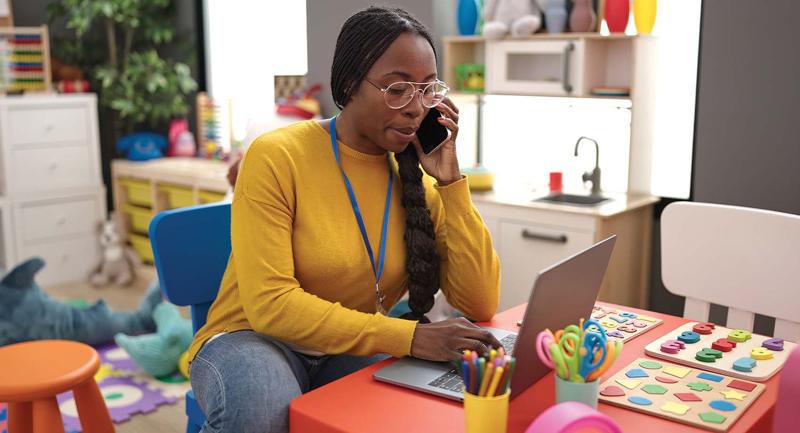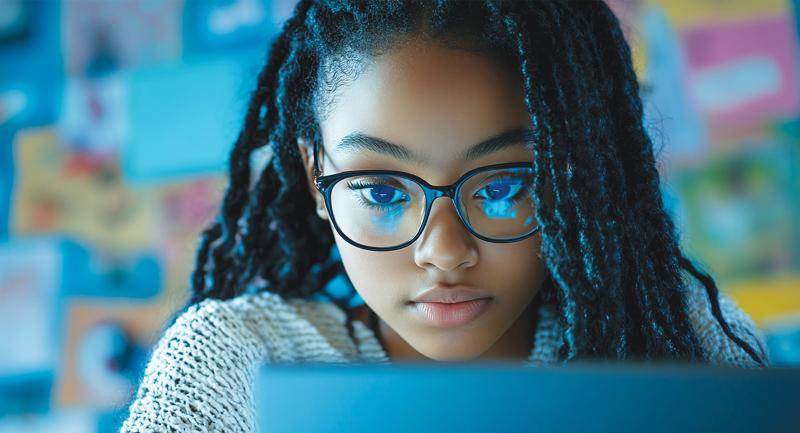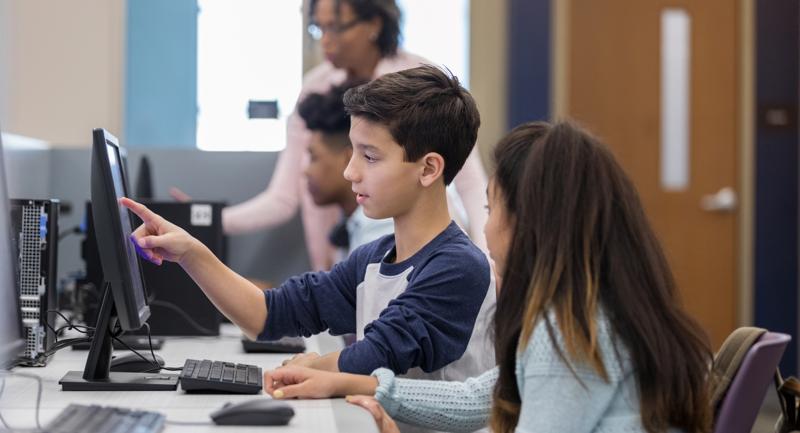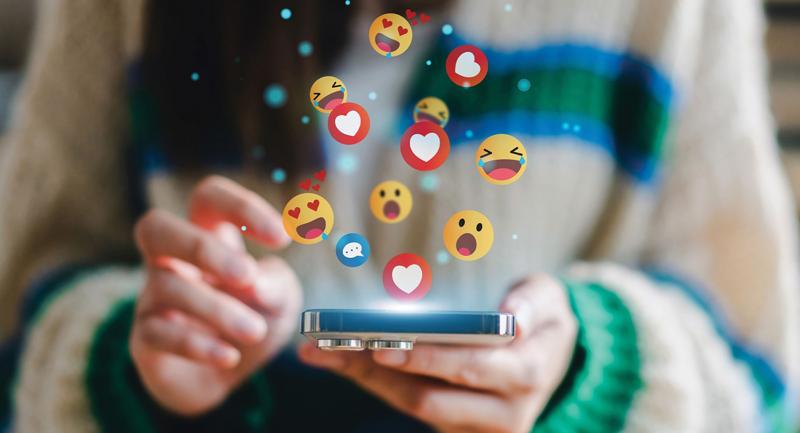The blended learning model—the combination of online learning and brick-and-mortar schooling—is not new. But as this model continues to evolve and mature, it's producing new kinds of learning experiences.
Blended learning began decades ago as a practical solution to fill gaps in access to curriculum content. Schools that couldn't offer certain advanced or elective coursework found an answer in online courses that could affordably deliver content to students anytime and anywhere, often reaching across district and state lines. Although students continued to take traditional face-to-face classes, they could supplement these courses with online courses.
Online coursework was a breakthrough in its own right. But these course offerings eventually expanded to include a wider array of instructional models, taking advantage of the power of technology to rethink the choreography of the traditional classroom. Early blended models took the flexibility and accessibility of online learning and integrated it into brick-and-mortar classrooms, creating more differentiation while still maintaining age-based cohorts and course structures. By shifting some instruction online, teachers could devote more of their limited time to face-to-face coaching and small-group instruction, mainstays of any differentiated model. And online software tools could also collect more and better data on how students were performing, thus enabling teachers to differentiate even more effectively.
In more recent years, the twin drumbeats of personalization and deeper learning have grown louder. The urge to use technology to meet the individual learning needs of every student undergirds a shift in blended learning that is well underway.
Teachers in this latest style of blended learning use technology not only to differentiate with greater precision, but also to do away with the strict silos of bell schedules, courses, and age-based cohorts and to create richer experiences that produce deeper learning, such as projects spanning several weeks. In these blended learning models, technology does not just play an instructional role, delivering content and assessment on a flexible basis as students are ready. It also plays an infrastructure role, coordinating scheduling, testing, and student progress. These models often offer various learning pathways and modalities, rather than a single pathway or progression. Consequently, students have greater choice over what and how they learn.
Three Trends in Blended Learning
Over the last five years, the Clayton Christensen Institute has tracked the growth of these models in our Blended Learning Universe directory, which profiles more than 400 blended learning schools. The data we've collected over the past six months points to three trends we're watching as schools continue to expand and evolve their blended approaches. Schools Continue to Adopt Station Rotation
Station Rotation is one of the most popular blended learning models and the fastest-growing model, according to our data. Station Rotation is particularly popular among elementary schools because its basic structure fits naturally into many traditional elementary classrooms. Historically, elementary school teachers have used centers—dividing young students into small groups and rotating them among different learning stations—to organize and manage classroom learning. Adding a station with online learning to an existing center model comes naturally.
For example, at Bella Romero Academy, a K–8 public school in Greeley-Evans School District in Colorado, Station Rotation powers the school's goal of increasing the degree of personalization in each student's education. Principal Jonathan Cooney didn't mandate any particular model of blended learning; instead, his team identified principles that any instructional model should incorporate. "We articulated that the model used by each professional should include four key elements: tight feedback loops, targeted instruction, student ownership of learning, and high-quality peer-to-peer interactions." Cooney found that most teachers adopted Station Rotation as the best entry point to guarantee these key elements while increasing personalization.
Deagan Andrews, director of instructional technology for Greeley-Evans, has seen the same pattern in other schools across the district. "Our design teams, composed of teachers and principals, seem to gravitate toward a rotational model. I think Station Rotation provides a concrete place to start, and they can see how to implement and incorporate digital content, collaboration, and small- group instruction," he said.
Of course, Station Rotation merely describes the choreography of a classroom; any number of activities or designs can occur within and between given stations. Teachers at Bella Romero are finding ways to better differentiate instruction to align more precisely to students' needs. For example, students complete different work at the "same" station, based on their individual needs. "Students needing fluency use Achieve3000 as a digital tool, while those working on comprehension use i-Ready," Cooney said. "On their paper-and-pencil learning guide, different standards are highlighted to guide what work students will complete based on teacher analysis of student work already completed."
These efforts to differentiate instruction with greater precision are paying off. At Bella Romero, 93 percent of students qualify for free or reduced-price meals, 89 percent are ethnic minorities, and 60 percent are English language learners. Since adopting blended learning, the school has seen marked growth. In just three years, it has transformed from a struggling school to one that earned Colorado's highest designation for schools. According to internal testing data, the school is showing significant growth for English language learners and students who qualify for free or reduced-price meals.
Schools Explore Ways to Unlock Flexible Pacing
It's unlikely that the growth of Station Rotation will slow down anytime soon. However, educators are also starting to look for elbow room around pacing and flexibility within their rotation models by freeing students and teachers from stringent time-based practices.
At Bella Romero, for example, teachers have often found that rotating students strictly on a timer—for instance, 20 minutes per station—may conflict with efforts to make the most effective use of digital content. A student may be required to change stations just minutes before finishing, or may start a lesson with only minutes remaining at the station. "Timer-based rotation seems less sensible to students and often causes them to budget their effort. If a student is finished with a lesson and five minutes remain, he simply kills the time," Cooney said.
To avoid time being wasted, Bella Romero teachers have loosened strict time allotments and instead designed a "tap-out" system that keeps students on task. Students are paired or put in groups of three, and when one student finishes his assigned lesson on the digital tool, he notifies the partner, who then takes her turn on the device.
In the coming years, we anticipate that middle schools may lead the way in pushing Station Rotation models even further toward the flexible use of time and pace, both within rotation models and by shepherding new models into the mix. At Piedmont Middle School in Piedmont, Alabama, for example, school leaders had observed that advanced students were not being challenged enough and struggling students were not receiving sufficient help from teachers to make meaningful progress. Although Piedmont had a 1:1 laptop program at the time, and several teachers were using Station Rotation, school leaders were not seeing the growth in student achievement they desired.
To address this challenge and give students more ownership of their learning, Piedmont shifted to a new model in 2014. Students now spend their time in three blocks each day: Class Time, Team Time, and My Time. This structure enables students to progress at their own pace and gives teachers ample time to work with students individually and in small groups.
Class Time is a rotation learning period during which students work independently and at their own pace on online content in math and reading and then apply the concepts and skills they gained from the online content in interdisciplinary projects. Each project is linked to standards and is assigned to students when they reach those specific standards.
During Team Time, students meet in a small team with a teacher who serves as a mentor to help them set short-term and long-term goals, build relationships, and explore personal interests. A given team stays with the same teacher throughout middle school. "We wanted to create a family atmosphere inside the school so every student has an adult here who monitors them and knows them from year to year," Snow said. Teachers use formative assessments to monitor and focus their team's efforts. During this time, students also have the opportunity to split off individually and take "à la carte" online high school courses to work on content above their grade level.
During My Time, students drive their own learning and apply the self-directed learning strategies they developed during Team Time. They use an adaptive online curriculum to progress independently on specific goals they set with their teachers, focusing on the core subjects in which they are furthest behind as determined by their scores on the Northwest Evaluation Association's MAP assessments. Students who are fully caught up can choose which core subjects to work on during My Time. Students also have opportunities to collaborate with a teacher, an intern, or their peers to improve their learning. Teachers spend half of the My Time period reflecting on students' data with their grade-level teams; they spend the other half providing targeted instruction to students.
High Schools Disrupt Traditional Structures with the Flex Model
At the high school level, given that older students have different development and instructional needs and teachers are more focused on teaching specific subjects and courses, we see different blended learning models thrive. These disruptive innovations tend to start outside mainstream classrooms, and then make their way to the core after they've proved effective.
For example, in 2014, Western Wayne Schools in Pershing, Indiana, created an alternative blended learning program to support high school students who were failing courses and in danger of dropping out. Although the district's students had a 90 percent passing rate on state exams in elementary and middle school, high school teachers complained that some students were entering high school academically unprepared. The alternative program began as a school-within-a-school model, in which students could enroll in online courses to recover credits while also enrolling in traditional courses. Students could complete their credit-recovery courses at any time instead of re-enrolling in courses and completing them on a semester schedule.
Recognizing that this flexibility in pacing could benefit all students, the district recently expanded the program to offer online courses as an option for all high school students. Students can choose to enroll in an online course, which they complete at their own pace in a flexible classroom environment with a teacher during the school day. These flexible learning environments often look more like tutoring or group-study sessions than traditional classrooms.
In describing the changes the district has made to support these blended efforts, assistant superintendent George Philhower said, "We have made adjustments to how we look at traditional school timelines (grading periods, semesters, class periods, grade levels) and have begun to shift to a system that guarantees learning instead of seat time. Instead of receiving credits at the end of the semester, students at our high school are earning credits based on when they complete their coursework."
Wayne's new model has been especially powerful for students who had often fallen through the cracks. "In the traditional system, students who failed a class had to repeat it the following semester, sometimes the following school year. They would often fall into a 'failure trap,' where it soon becomes impossible to pass while juggling other course loads," Philhower said. "Now, students have the flexibility to complete coursework in whatever way works best for them."
Districts like Wayne are seeing promising results with a disruptive blended learning model that upends, rather than reinforces, seat time. Such a model also tends to disrupt the traditional role of teachers as deliverers of content. As Chris Walter, a blended learning math and science teacher at Innovations Early College High School in Salt Lake City, Utah, said, "One of the biggest struggles for me is giving away a lot of control." Walters's school operates a Flex model of blended learning, in which students access all the assignments and learning resources for most of their courses online. "I am no longer responsible for making each student do my assigned task at the time appointed by me. Instead, I've needed to shift to identifying and helping the students that need additional support."
That shift, although a promising on-ramp to more flexible learning environments, may not come quickly in high schools where teachers are used to overseeing specific content areas and delivering content through traditional lectures and course structures. Therefore, we expect that models that preserve course structures—particularly flipped classroom models, in which teachers record their own lectures or leverage open education resources and then use class time for projects or differentiated instruction—will continue to increase in popularity.
Moving Forward
These three trends are consistent with the manner in which innovations tend to unfold. On the one hand, classrooms are quickly turning to models like Station Rotation and flipped instruction, which sustain but improve on traditional time and cohort-based classrooms. On the other hand, disruptive instructional models are taking root beyond the traditional classroom as schools strive to move beyond stringent pacing and course structures.
With an eye on innovative models and better outcomes, blended learning is still in flux, in the best sense of the word. Schools are innovating rapidly; indeed, in the past six months, we've seen at least a dozen schools that have shifted from using a single model of blended learning to using multiple models. More than 81 of the now 400-plus active schools in our database use a combination of two or more blended learning models. As we talk to educators, our intuition is that this is a sign of things to come.
Authors' note: Are you building a blended learning model at your school? Add your school to the Christensen Institute's Blended Learning Universe.
Blended Learning Models
The majority of blended-learning programs resemble one of four models:
Students rotate on a fixed schedule or at the teacher's discretion between learning modalities, at least one of which is online learning. Other activities might include small-group or full-class instruction, group projects, individual tutoring, and pencil-and-paper assignments. The students learn mostly on the brick-and-mortar campus, except for any homework assignments. Variations include Station Rotation, in which all students rotate through the same stations within a contained classroom, and Flipped Classroom, in which students participate individually in online learning off-site and then attend the brick-and-mortar school for teacher-guided practice and projects.
Online learning is the backbone of student learning, even if it directs students to offline activities at times. Students move on an individually customized, fiuid schedule among learning modalities. The teacher of record is on-site, and students learn mostly on the brick-and-mortar campus, except for any homework assignments. The teacher or other adults provide face-to-face support on a flexible and adaptive as-needed basis through activities such as small-group instruction, group projects, and individual tutoring.
Students take one or more courses entirely online to accompany other experiences they are having at a brick-and-mortar school or learning center. The teacher of record for the online course is the online teacher. Students may take the online course either on the brick-and-mortar campus or at the learning center.
Students attend required face-to-face learning sessions with their teacher of record and then are free to complete their remaining coursework remotely, apart from the face-to-face teacher. The same person generally serves as both the online and face-to-face teacher.
Source: From Blended: Using Disruptive Innovation to Improve Schools, by M. B. Horn and H. Staker, 2014. San Francisco: Jossey-Bass. Copyright © 2014 Michael B. Horn and Heather Staker. Used with permission.









